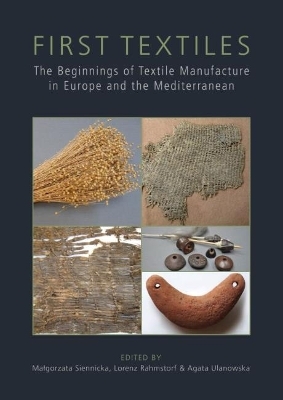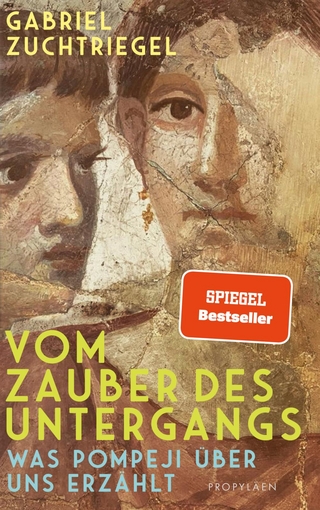
First Textiles
Oxbow Books (Verlag)
978-1-78570-798-8 (ISBN)
- Titel ist leider vergriffen;
keine Neuauflage - Artikel merken
Textile production and the manufacture of clothing was one of the most essential daily activities in prehistory. Textiles were significant objects of practical use, and at the same time had cultural, social and symbolic meaning, crucial for displaying the identity, gender, social rank and status, or wealth of their users. However, evidence of ancient clothing is scarce due to unfavourable preservation of organic materials. Only occasionally are prehistoric textiles and associated implements preserved, mainly as a result of exceptional environmental conditions, such as waterlogged contexts like bogs, or in very dry or cold climates. In other cases textiles are sporadically mineralised, carbonised or preserved by metal corrosion. Textiles and leather can also be visible as imprints on clay.
The beginning of textile manufacture is still vague, but can be traced back to the upper Palaeolithic. Important developments in textile technology, e.g. weaving, spinning with a spindle, introduction of wool, appeared in Europe and the Mediterranean throughout the Neolithic, Chalcolithic and Early Bronze Age. This book is devoted to the early textile production in Europe and the Mediterranean and aims to collect and investigate the combined evidence of textile and leather remains, tools, workplaces and textile iconography.
The chapters discuss the recent achievements in the research of ancient textiles and textile production, textile techniques such as spinning, fabric and skin manufacture, use of textile tools and experimental textile archaeology. The volume explores important cultural and social aspects of textile production, and its development.
Małgorzata Siennicka is an Associate Professor at the Saxo Institute, University Copenhagen and holds a PhD in Aegean archaeology from Warsaw University. Her research interests focus on the Neolithic and Bronze Age Aegean and Eastern Mediterranean, prehistoric cloth and textile production, craftsmanship, balance weights and metrology, settlements and architecture. She was awarded with a Marie Skłodowska-Curie fellowship at The Centre for Textile Research at the University of Copenhagen (2013-2017). In 2013-2017 Małgorzata Siennicka directed an international research project “First Textiles” at the Centre for Textile Research in Copenhagen. Lorenz Rahmstorf is a Professor in the Department of Prehistory and Early History at the University of Göttingen. His research interests focus on the third and second millennia BC Aegean, Europe and West Asia and more specifically on weight metrology, early trade, textile production, transfer of innovations and urbanisation processes. He has obtained an MA (Bristol), PhD (Heidelberg) and Habilitation (Mainz), and participates in various international research projects. In 2015 he was awarded an European Research Council Consolidator Grant to lead a 5-years project “Weight and value. Weight metrology and its economic and social impact on Bronze Age Europe, West and South Asia”. Agata Ulanowska is an Assistant Professor in the Centre for Research on Ancient Technologies of the Institute of Archaeology and Ethnology Polish Academy of Sciences in Łódź and Senior Lecturer at the Institute of Archaeology, University of Warsaw (sabbatical). Her research interests focus on the Bronze Age Aegean, textile production and technology, experimental and experience archaeology and Aegean seals and sealing practices. She holds a PhD in Aegean archaeology from the University of Warsaw. In 2015-2017 she was awarded with FUGA post-doctoral grant of the National Science Centre for the project “Textile production in Bronze Age Greece – comparative studies of the Aegean weaving techniques”.
List of contributors
Preface
1. Introduction
Małgorzata Siennicka, Lorenz Rahmstorf and Agata Ulanowska
2. Early loom types in ancient societies
Eva Andersson Strand
3. Discussing flax domestication in Europe using biometric measurements on recent and archaeological flax seeds – a pilot study
Sabine Karg, Axel Diederichsen and Simon Jeppson
4. From adorned nudity to a dignitary’s wardrobe: symbolic raiment in the southern Levant 13 500 BC–3900 BC
Janet Levy
5. The earliest cloth culture in Denmark
Ulla Mannering
6. Loom weights and weaving at the archaeological site of São Pedro (Redondo, Portugal)
Catarina Costeira and Rui Mataloto
7. Evidence of textile technology in the Early Neolithic site of La Draga (Banyoles, Spain). Some hypotheses
Miriam de Diego, Raquel Piqué, Antoni Palomo, Xavier Terradas, Maria Saña, Ignacio Clemente and Millán Mozota
8. From east to west: the use of spinning bowls from the Chalcolithic period to the Iron Age
María Irene Ruiz de Haro
9. From the loom to the forge. Elements of power at the end of Neolithic in western Europe: a focus on textile activities
Fabienne Médard
10. Textile manufacture in the prehistoric pile dwellings of south-west Germany: planned investigation
Johanna Banck-Burgess
11. Late Neolithic weaving tools from Melk-Spielberg in Austria: experiments with crescent-shaped weights
Karina Grömer
12. Two sides of a whorl. Unspinning the meanings and functionality of Eneolithic textile tools
Ana Grabundžija
13. Plant textiles in a grave mound of the Early Bronze Age in eastern Romania
Neculai Bolohan and Ciprian-Cătălin Lazanu
14. Social contexts of textile production in Bulgaria during the Late Chalcolithic: from multimedia work-areas to material, social and cultural transformations
Petya Hristova
15. Experimenting with loom weights. More observations on the functionality of Early Bronze Age textile tools from Greece
Agata Ulanowska
16. Textile tools and manufacture in the Early Bronze Age Cyclades: evidence from Amorgos and Keros
Giorgos Gavalas
17. Fibre crafts and social complexity: yarn production in the Aegean islands in the Early Bronze Age
Sophia Vakirtzi
18. In search of ‘invisible’ textile tools and techniques of band weaving in the Bronze Age Aegean
Agata Ulanowska
19. The Early Bronze Age textile implements from the Eskişehir region in inland north-western Anatolia
Deniz Sarı
20. Investigating continuity and change in textile making at Arslantepe (Malatya, Turkey) during the 4th and 3rd millennia BC
Romina Laurito
| Erscheinungsdatum | 12.02.2019 |
|---|---|
| Reihe/Serie | Ancient Textiles Series ; 32 |
| Zusatzinfo | b/w and colour illus. |
| Verlagsort | Oxford |
| Sprache | englisch |
| Maße | 216 x 280 mm |
| Themenwelt | Sachbuch/Ratgeber ► Freizeit / Hobby ► Handarbeit / Textiles |
| Geisteswissenschaften ► Archäologie | |
| Geschichte ► Allgemeine Geschichte ► Vor- und Frühgeschichte | |
| Geisteswissenschaften ► Geschichte ► Regional- / Ländergeschichte | |
| Technik | |
| ISBN-10 | 1-78570-798-1 / 1785707981 |
| ISBN-13 | 978-1-78570-798-8 / 9781785707988 |
| Zustand | Neuware |
| Informationen gemäß Produktsicherheitsverordnung (GPSR) | |
| Haben Sie eine Frage zum Produkt? |
aus dem Bereich


